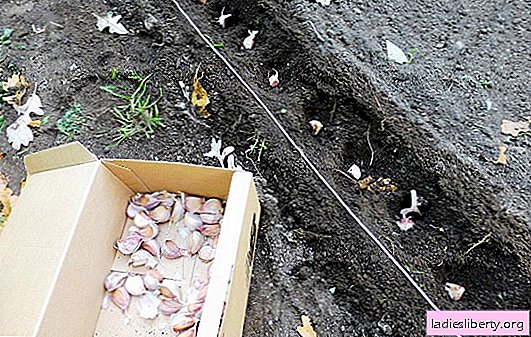
Garlic has many useful properties, it is grown by every summer resident.
However, not everyone can get a good harvest.
In order to have excellent teeth in the summer, you need to properly plant garlic in the fall.
And you need to start with the choice of planting material, preparation of beds and much more.
How to understand that winter garlic?
First, the gardener must decide which kind of garlic he wants to grow. The fact is that this culture is divided into several types:
• spring garlic;
• winter garlic.
These species differ from each other externally in the number and shape of the teeth.
1. The cloves of winter garlic are large, uniform in size. They are evenly distributed around the base in one row.
2. Varieties of winter garlic give a flower arrow that forms bulbs.

They dig up winter garlic early, use it for summer consumption or for harvesting. For longer storage, varieties of spring garlic are grown. This article will focus on the cultivation of winter garlic.
Benefits of Planting Winter Garlic
Some gardeners prefer to grow spring garlic, as its shelf life is higher. However, planting winter garlic has a number of advantages.
1. Saving time during spring work. The landing dates are extended, which allows you to take your time and prepare well for the procedure. In the spring there is too much work in the garden, there is no time for high-quality preparation of beds and material, and in the fall it is much more.
2. Winter garlic is not afraid of frost, while return frosts can destroy the tender shoots of spring garlic.
3. Planting material is quite large, and a small fraction of spring garlic often dries out by the time of planting.
4. Winter garlic is undemanding in care, as there is enough soil moisture for its development.
5. Winter varieties of garlic are more resistant to pests, less affected by various diseases.
6. The yield of winter garlic is much higher than spring.
7. Harvesting takes place a month earlier, which allows the use of garlic for summer consumption.
The best varieties of winter garlic
An important factor on the way to the harvest is the variety that is cultivated on the site. Seasoned summer residents prefer purple-striped varieties of garlic. In the people they are so called for the coloring of scales. Indeed, these varieties are most resistant to disease and frost. Commercial quality heads at the highest level. Bulbs are formed weighing about 150 grams each.
• Gribovsky Jubilee;
• Komsomolets;
• Polessky;
• Scythian;
• Garpek.

Planting dates for winter garlic in autumn
An experienced gardener knows that only a good harvest can be obtained only when planting is done on time. Many people confuse the types of garlic and plant them in the wrong time, which reduces the quality of the crop and its quantity.
For an early harvest, winter garlic is planted in the fall. If it is planted in the spring, then the teeth will not be tied, and a lush, green tops will grow. The formation of the head occurs in certain conditions.
What to consider when planting winter garlic
The timing of the autumn winter winter planting of garlic for each region will differ, but following some rules will help determine the exact time.
1. It is better to plant the prepared material a month before the alleged frosts. Leave about 3 weeks to root the teeth.
2. In the middle zone, the period for autumn planting of garlic falls on the end of September - beginning of October. In a month, the teeth will form a powerful root system, which is the key to a plentiful harvest.
Colds and frosts are not afraid of garlic, if the root system has developed sufficiently, but the late planting leads to the fact that the roots are poorly formed. This leads to the fact that the teeth die in the winter.
Important! You should not rush too much with planting, you should not allow the germination of winter garlic in the fall.
Preparing planting material
The harvest of the next year also depends on the quality of the cloves. All planting material undergoes rigorous processing and preparation.
• For planting, choose well-dried heads, which are carefully divided into teeth, being careful not to damage the scales.
• The selected material is sorted. The teeth should be healthy, with no visible signs of illness, stains, cracks or injuries. Spoiled teeth rot and can infect the entire garden.
• It is better to plant those varieties that are cultivated in the region. This will provide a more stable crop.
• All teeth undergo preplant treatment. Garlic is soaked for several minutes in a salt solution. To do this, add 3 tbsp to 5 liters of water. tablespoons of salt.
• Next, disinfect the planting material. The teeth are immersed in a solution of copper sulfate. For 10 liters of water add 1 tbsp. a spoonful of vitriol. Teeth stand one to two minutes.

Advice! If you want to grow a crop of large garlic, then only large teeth are selected for autumn planting.
Seasoned summer residents to disinfect planting material use a solution of potassium permanganate, the drug "Fitosporin-M", an infusion of ash. Prepared and sorted teeth last about 30 minutes.
Preparation of beds for autumn planting of garlic + photo
Another factor affecting yield is the soil in which garlic is grown. The quality of the obtained heads directly depends on its structure and composition. Therefore, the preparation of the soil must be given special attention. What does it mean?
1. The bed for the autumn planting of garlic is prepared in advance. As a rule, a month before the proposed landing.
2. Too dense soil is not suitable for growing garlic, so it must be loosened.
3. The ideal soil for garlic is loam.
4. A good crop is obtained only in a land rich in nutrients. Fertilizers will help to improve the composition of the soil.
What fertilizers to use when preparing the beds for the autumn planting of garlic
The quantity and type of fertilizer depends on the soil in which the cultivation is planned. Mineral complexes are introduced into loamy soil for digging. For 1 square. meter:
• 1 cup dolomite flour;
• 1 tbsp. a spoon of superphosphate;
• 1 tbsp. spoon of nitrophoska
It is possible to enrich the soil with organic fertilizers. Suitable humus or compost, one bucket per 1 square. m. beds.
Other types of soil fertilize differently.
1. Clay soil enriched with peat. 1 bucket per 1 square. meter beds.
2. Peatlands are bred with loamy soil.
3. Sandy soils need fertilizer as for loam, but with the addition of peat.
All fertilizers are applied for digging the beds. Loosen the earth to a depth of 20 cm. Then form and compact the landing site.
The finished garden is watered with a disinfecting solution. For this, copper sulfate is used. 50 grams are bred in 10 liters of water. the drug. The garden is watered and covered with a film until planting.
Light and loose earth, which is enriched with nutrients, allows you to grow large and healthy garlic.
Planting garlic
A garlic bed is best placed in a well-lit place. This culture does not like stagnation of water, excess moisture contributes to the development of fungal diseases. If there is no other place, then you can correct the situation by arranging high beds.
Most often, garlic in the garden is grown in rows. The distance between them is about 25-30 cm, which facilitates the care of the crop. Teeth in rows are planted at a distance of about 10 cm from each other. However, this depends on the size of the planting material. Larger teeth need more space, while smaller ones can be planted denser.
The depth of the cloves depends on the time of planting of garlic. In autumn, for winter sowing, furrows are made deeper, about 10 cm. Insufficient planting depth will cause the garlic to freeze. In harsh climates, gardeners practice mulching beds with straw or dry grass. However, in early spring, shelter must be removed.

Furrows for planting are made parallel to each other, and the teeth are planted strictly vertically, with the bottom down. In the formation of beds there is nothing difficult, adhering to all the rules, you can expect a good harvest next summer.
Top 10 secrets for a good harvest of winter garlic
1. After processing, planting material must be planted immediately. If this is not possible, then it is better to store it no longer than a week. Further, the percentage of germination of cloves is reduced.
2. Experienced gardeners know how crop proximity in the garden affects crop yields. The best precursors of garlic are greens, root vegetables, cucumbers, tomatoes, eggplant, cabbage and zucchini. You can grow garlic on the same bed with strawberries, cucumbers and tomatoes.
3. You can not plant garlic after onions. You can return the culture to its former place in three years.
4. Strict observance of the dates of winter planting of garlic in the fall.
5. For planting, select high-yielding proven varieties. You should not expect a good harvest from a low-yielding variety.
6. Timely updating of planting material. Garlic, like any other culture, is gradually degenerating. Once every three years, you need to rejuvenate the variety. To do this, leave a few arrows, from which the bulbs are obtained. In the first year, single teeth grow out of them. Having landed toothpicks in the autumn in the garden, in the summer they get freight heads.
7. Compliance with the timing of the harvest. In each region they differ. You can determine the exact date using the arrow. As soon as it burst, and the bulbs appeared, the garlic ripened.
8. Breaking out the shooter allows you to grow larger heads of garlic, accelerates the ripening process.
9. Compliance with the exact watering regime. In the first phase of growth, winter garlic is watered abundantly, and by the end of the growing season, watering is stopped.
10. Mulching the beds with garlic favorably affects the formation of heads. Mulch helps retain moisture, which is necessary for the formation of large teeth.
Advice! If you carry out the releasing of beds in the second half of June, this contributes to the formation of a more even and large head.
What to consider when growing winter garlic
Despite all the tricks, it will not work to grow large garlic without the necessary nutrition. During the growing season, winter garlic needs to be fed several times.
The first feeding is done at the beginning of the growing season, when the first leaves appeared. During this period, nitrogen fertilizers are used. Experienced gardeners water the bed with infusion of mullein or chicken droppings. In 10 liters of water insist 1 kg of the substance. After completion of the fermentation process, the solution is diluted with water in a ratio of 1:10, 10 parts of water are taken for 1 part of the infusion.
The second top dressing is carried out at the time of formation of the head. The solution is used the same.
Harvesting should take place at certain times, which affects the quality. They dig up winter garlic when the leaves begin to turn yellow. Pitch the garden bed with a fork, gently removing the garlic. The harvested crop is shaken off the ground and dried.

Dry garlic in the shade under a canopy. Stems and roots cannot be picked. They must dry themselves. During the drying process, all the nutrients from the stem are lowered into the head. During the drying of the crop, it is periodically inspected and ted. Particular attention is paid to the lower layers, as they can be worn.
When the garlic has dried out well, the stems are cut to a height of 10 cm, the remnants of dry roots are removed and the heads are laid for storage. In this form, the crop is stored until planting.

In conclusion, we can say that garlic is an unpretentious crop. Growing it is not a hassle, but taking into account all the above rules is necessary to get a good harvest of winter garlic.












